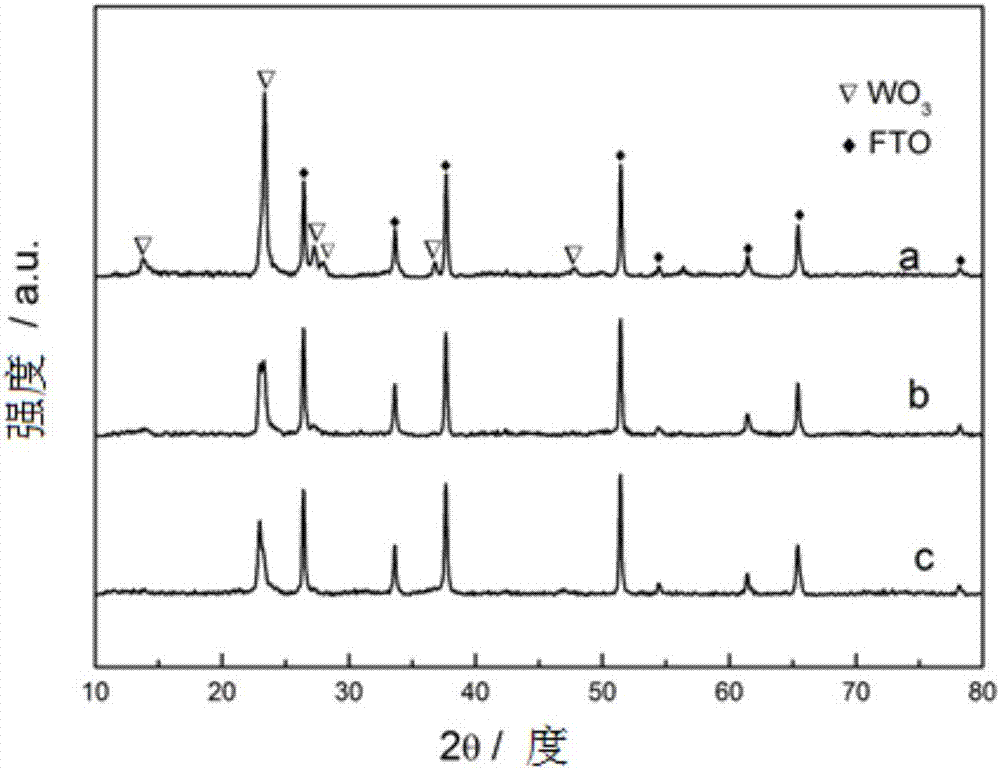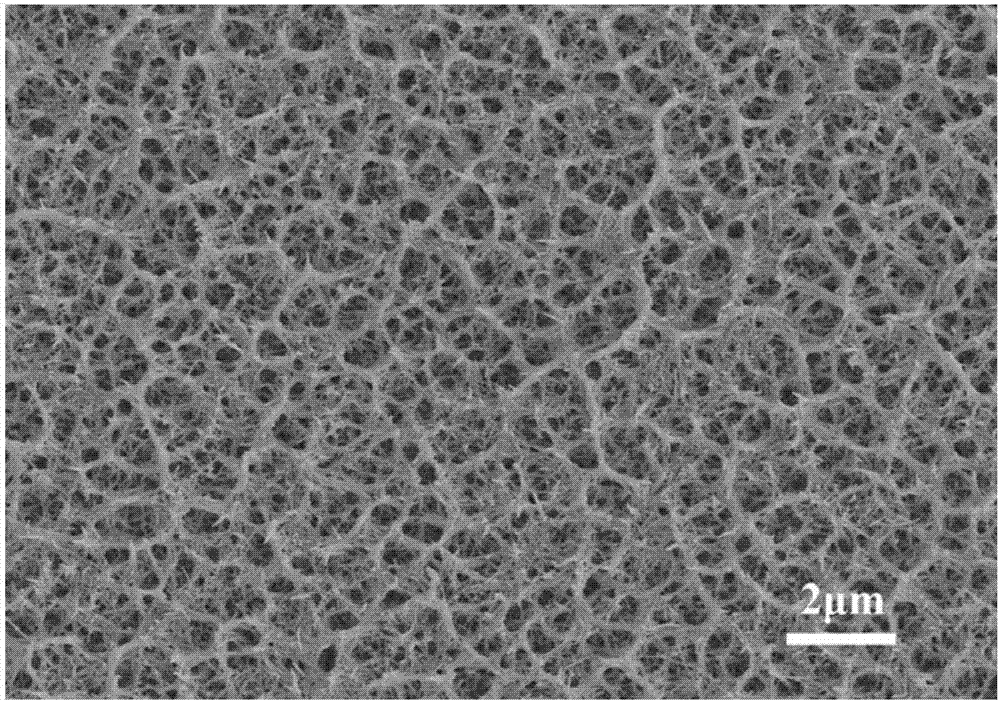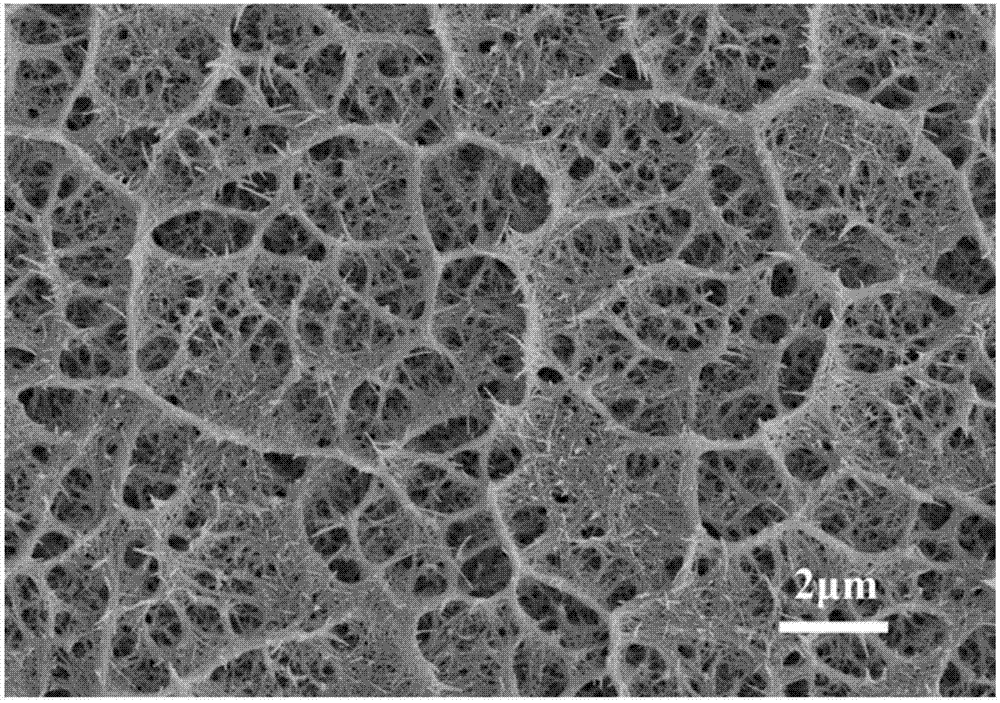Preparation method for tungsten trioxide nanowire electrochromic film
A technology of tungsten trioxide and rice noodle electricity, applied in the direction of tungsten oxide/tungsten hydroxide, nanotechnology, coating, etc., can solve problems such as hindering practical application, low coloring efficiency, slow discoloration speed, etc., and achieve controllable hydrothermal process. , Improve the adhesion performance, the effect of fast discoloration
- Summary
- Abstract
- Description
- Claims
- Application Information
AI Technical Summary
Problems solved by technology
Method used
Image
Examples
Embodiment 1
[0037] (1) Clean the FTO conductive glass sequentially with acetone, ethanol, and deionized water ultrasonically, each cleaning time is 20 minutes, and dry it for later use;
[0038] (2) Weigh 0.25g tungstic acid and dissolve it in 15mL hydrogen peroxide solution with a mass fraction of 30%, then add 50mL deionized water, continue stirring for 8h, after forming a preliminary sol, continue aging for 24h to obtain tungsten acid sol, and then the tungstic acid sol was spin-coated on the FTO conductive glass at a rate of 3000rpm, and the spin-coating time was 20s, and then the FTO conductive glass was annealed at 400°C for 40min to obtain a 3FTO conductive glass of the seed layer;
[0039] (3) Weigh 1.32g of sodium tungstate dihydrate and dissolve it in 18mL of deionized water, add 2.5mL of 3mol / L hydrochloric acid solution to adjust the pH value to about 2, then add 1.056g of ammonium sulfate and 12mL of ethylene glycol, and continue stirring for 30min. Obtain a stable tungsten ...
Embodiment 2
[0051] (1) Clean the FTO conductive glass sequentially with acetone, ethanol, and deionized water ultrasonically, each cleaning time is 20 minutes, and dry it for later use;
[0052] (2) Weigh 0.25g tungstic acid and dissolve it in 15mL hydrogen peroxide solution with a mass fraction of 30%, then add 50mL deionized water, continue stirring for 8h, after forming a preliminary sol, continue aging for 24h to obtain tungsten acid sol, and then the tungstic acid sol was spin-coated on the FTO conductive glass at a rate of 3000rpm, and the spin-coating time was 20s, and then the FTO conductive glass was annealed at 400°C for 40min to obtain a 3 FTO conductive glass of the seed layer;
[0053] (3) Weigh 1.32g of sodium tungstate dihydrate and dissolve it in 22mL of deionized water, add 2.5mL of 3mol / L hydrochloric acid solution to adjust the pH value to about 2, then add 1.056g of ammonium sulfate and 8mL of ethylene glycol, and continue stirring for 30min. Obtain a stable tungsten ...
Embodiment 3
[0064] (1) Clean the FTO conductive glass sequentially with acetone, ethanol, and deionized water ultrasonically, each cleaning time is 20 minutes, and dry it for later use;
[0065] (2) Weigh 0.25g tungstic acid and dissolve it in 15mL hydrogen peroxide solution with a mass fraction of 30%, then add 50mL deionized water, continue stirring for 8h, after forming a preliminary sol, continue aging for 24h to obtain tungsten acid sol, and then the tungstic acid sol was spin-coated on the FTO conductive glass at a rate of 3000rpm, and the spin-coating time was 20s, and then the FTO conductive glass was annealed at 400°C for 40min to obtain a 3 FTO conductive glass of the seed layer;
[0066] (3) Weigh 1.32g of sodium tungstate dihydrate and dissolve it in 26mL of deionized water, add 2.5mL of 3mol / L hydrochloric acid solution to adjust the pH value to about 2, then add 1.056g of ammonium sulfate and 4mL of ethylene glycol, and continue stirring for 30min. Obtain a stable tungsten ...
PUM
| Property | Measurement | Unit |
|---|---|---|
| time | aaaaa | aaaaa |
Abstract
Description
Claims
Application Information
 Login to View More
Login to View More - R&D
- Intellectual Property
- Life Sciences
- Materials
- Tech Scout
- Unparalleled Data Quality
- Higher Quality Content
- 60% Fewer Hallucinations
Browse by: Latest US Patents, China's latest patents, Technical Efficacy Thesaurus, Application Domain, Technology Topic, Popular Technical Reports.
© 2025 PatSnap. All rights reserved.Legal|Privacy policy|Modern Slavery Act Transparency Statement|Sitemap|About US| Contact US: help@patsnap.com



